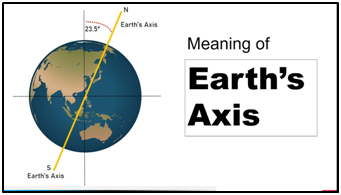Why in News?
- According to a new study, excessive extraction of groundwater for drinking and irrigation has shifted the Earth’s axis of rotation.
What’s in Today’s Article?
- About the Study (Findings of the Study, Impact on Earth’s Axis, Role of Groundwater, etc.)
About the Study:
- The study, ‘Drift of Earth’s Pole Confirms Groundwater Depletion as a Significant Contributor to Global Sea Level Rise 1993–2010’, was published in the journal Geophysical Research Letters, earlier this month.
- The study was carried out by researches from countries such as USA, South Korea, Australia and Hong Kong.
- The major highlight of the study is that excessive extraction of groundwater for drinking and irrigation has shifted the Earth’s axis of rotation.
- The study says that humans pumped out around 2,150 gigatons of groundwater between 1993 and 2010 and this has led the planet’s axis to drift at the rate of 4.36 cm per year towards the east.
- Although the shift is not significant enough to have real-life consequences, the study shows that humans have extracted so much water from the ground that it has impacted the planet’s axis and contributed to global sea level rise.
About Earth’s Axis:

- The Earth’s axis is the imaginary line through the earth that extends from the North Pole to the South Pole.
- Today, the Earth's axis is tilted 23.5 degrees from the plane of its orbit around the Sun.
- But this tilt changes. During a cycle that averages about 40,000 years, the tilt of the axis varies between 22.1 and 24.5 degrees.
- Scientists for years have known that the poles and the axis keep shifting naturally as the mass distribution in and on the planet changes. This phenomenon is known as “polar motion”.
- For instance, rocks slowly circulating inside Earth’s mantle causes the planet’s mass to shift, leading to a change in the position of the rotational axis.
- There are several other reasons responsible for polar motion like ocean currents and even hurricanes.
How Global Warming/Depletion of Groundwater Can Lead to Changes in Earth’s Axis?
- In 2016, a team of researchers demonstrated that climate-driven changes in water mass distribution, led by the melting of glaciers and ice in Greenland, can cause Earth’s axis to drift.
- In 2021, another study said climate change was causing the rotational axis to shift more than usual since the 1990s.
- The latest study published in the journal Geophysical Research Letters, earlier this month, took observational data spanning 17 years and a computer model to find out which factors affected the Earth’s rotation of axis the most.
- The study found redistribution of groundwater as the largest contributor to the drift of the rotational pole.
- The study also noted that the groundwater extraction from North America and northwestern India, both located at the Earth’s midlatitudes, had an outsized impact on the polar motion in comparison to the extraction taking place in poles or equators.
- The water sucked out from the ground for irrigation and meeting the world’s freshwater demands, eventually, goes into the oceans.
- The team that conducted the study confirmed that groundwater extraction is one of the major contributors to the global sea level rise.
- Their calculations matched with previous research, which estimated that groundwater extraction raised global sea levels by 6.24mm between 1993 and 2010.









